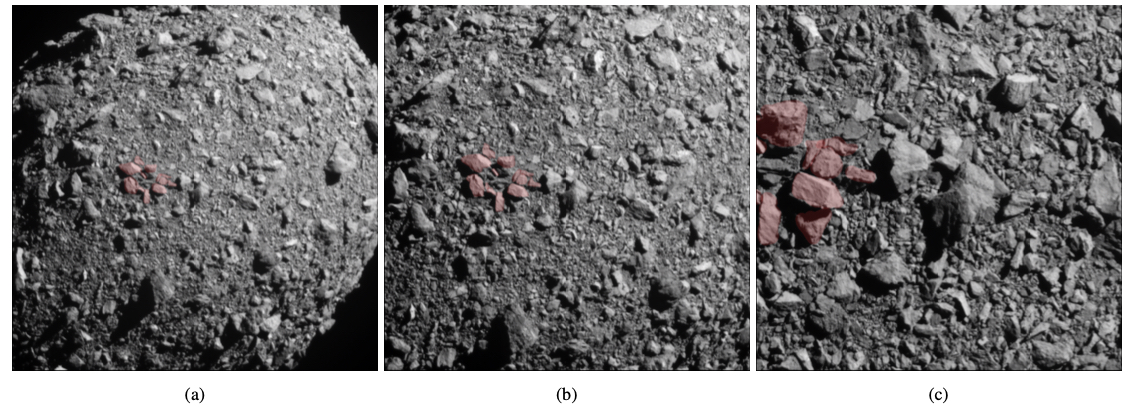SPH Simulations of Boulder Disruptions: from Laboratory Scale Impacts to Asteroids
- 1Space Research and Planetary Sciences, Physikalisches Institut, University of Bern, Switzerland (martin.jutzi@unibe.ch)
- 2Johns Hopkins University Applied Physics Laboratory, USA
- 3NASA Johnson Space Center, USA
The detailed observations of the boulder populations on rubble-pile asteroid surfaces such as Ryugu, Bennu or Dimorphos provide insights into their physical properties and the evolution of their host asteroids [1]. Asteroid surfaces evolve through impacts and thermal processing – both mechanisms that may lead to boulder fragmentation (Figure 1).

Figure 1: a) - c) Images acquired by the DART spacecraft approaching the surface of Dimorphos. Boulders which may have originated as a result of an impact event on the asteroid surface are highlighted in red (NASA/Johns Hopkins APL).
Here, we present numerical simulations using the Bern SPH code [2] to study the impact fragmentation of boulders on asteroid surfaces. Before applying our models to asteroid scales, we successfully validated them by comparing the results with boulder disruptions observed in laboratory impact experiments [3].
In scenarios of impacts on rubble-pile asteroids, our Bern SPH simulations include the displacement and late-stage evolution of the boulder fragments, using a recently developed approach [4,5]. This allows us to determine their final position on the asteroid surface or if they are ejected from the asteroid.
Our initial results suggest that only for boulders with a relatively low bulk tensile strength (<≈ 104-105 Pa) would the impact fragmentation allow the fragments to stay on the asteroid surface close to the impact point. For higher boulder tensile strength, the specific impact energies required for boulder fragmentation lead to fragment velocities above the escape speed of small asteroids (of the order of tens of cm/s). Our results thus provide constraints for the boulder properties and implications for the surface evolution of rubble-pile asteroids through impact processes.
Figure 2: Bern SPH simulation of boulder fragmentation by impacts. The fate of the boulder fragments (final position on the surface or ejection) depends on the boulder strength, impact energy and surface gravity.
Acknowledgements: S.D.R. and M.J. acknowledge support from the Swiss National Science Foundation (project number 200021_207359). R.-L.B. was funded by NASA New Frontiers Data Analysis Program grant number 80NSSC22K1035.
References:
[1] Ballouz, R-L et al. (2023). “Disrupted Boulders on the Surfaces of Near-Earth Asteroids Bennu, Ryugu, and Dimorphos”. LPI Contributions 2806, p. 2505.
[2] Jutzi, M., Benz, W. & Michel, P. (2008) Numerical simulations of impacts involving porous bodies: I. Implementing sub-resolution porosity in a 3D SPH Hydrocode. Icarus 198, 242–255.
[3] Cline II, CJ et al. (2023). “Using Controlled Impact Experiments to Understand the Effects of Cohesive Blocks on the Cratering Process”. Lunar and Planetary Science Conference.
[4] Jutzi, M., Raducan, S. D., Zhang, Y., Michel, P. & Arakawa, M. (2022). Constraining surface properties of asteroid (162173) Ryugu from numerical simulations of Hayabusa2 mission impact experiment. Nature Communications 13, 7134
[5] Raducan, SD et al. (2024). “Physical properties of asteroid Dimorphos as derived from the DART impact”. Nature Astronomy 8, pp 445–455
How to cite: Della Moglie, P., Raducan, S. D., Jutzi, M., Ballouz, R. L., Cline, C. J., and Cintala, M. J.: SPH Simulations of Boulder Disruptions: from Laboratory Scale Impacts to Asteroids, Europlanet Science Congress 2024, Berlin, Germany, 8–13 Sep 2024, EPSC2024-803, https://doi.org/10.5194/epsc2024-803, 2024.